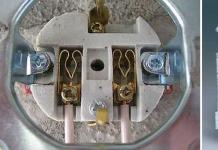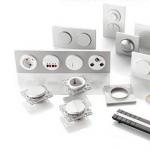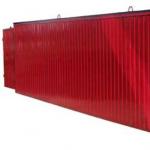Compliance with certain rules when running a household or maintaining retail space will avoid interest in him from birds. In grain barns, it is recommended to use bird-proof storage facilities, and on livestock farms, special drinkers and feeders should be used and keep order.
Plastic strips should be hung at the entrances to retail facilities, which completely close the opening from birds, allowing people with heavy bags and carts to move around. Also block ventilation and other entrances to the room, isolate roof structures and repair windows.
What birds are afraid of: an overview of the 7 best methods
If it is not possible to completely eliminate bird sightings, or if it is not economically feasible, try reducing the attractiveness of bird roosting and nesting sites. These methods are safe for people, livestock and "non-target" animals, but often require a lot of money and time to install -
To counter the arrival or nesting, various physical barriers, such as spikes on cornices, nets that protect garden crops from being eaten, changing the angle of the slope of cornices and window sills. Spikes and netting will help in the fight against pigeons and larger birds, but small species will be able to settle between the spikes or crawl into the mesh cell. Also, plants or other attractive places and objects can be treated with a spray or gel that has an unpleasant odor or irritates their mucous membranes. Having received a negative experience, a flock or an individual decides to leave the place.
To get rid of all types of birds, scientists advise resorting to deterrent methods, and it is desirable to alternate or combine them. The easiest option is to use dummies and scarecrows in the form of birds of prey or even in the form of eyes. Scientists approve the use of reflective devices: tapes, rails, disks. This method is considered one of the most common. But there are nuances: pests quickly get used to such items. And in windless gloomy weather, when the reflectors do not swing and do not make noise, there is little sense from them.
Stores also sell electronic repellents. Some - acoustic - act by ear. Another type is water repellers with a motion sensor, which release a jet of water towards the intruder. If the method with water is not in doubt, then with ultrasound the question is not so clear. Despite the fact that there are also positive reviews for such repellers, there are still more negative ones. Yes, and scientists doubt their effectiveness as an independent method. So, experts from the University of Nebraska-Lincoln state: “Acoustic devices by themselves are not effective against birds or are only effective for a short time. To be useful in such a matter, acoustic devices must be used in conjunction with other control methods. Their most effective use is possible when additional measures are applied, leading to the death or painful experience of some members of the population or pack ... ”.
Among other repellents that affect hearing, scientists distinguish programmable sound repellers. They record the voices of birds of prey that scare away different types of birds. Such devices can even be configured to scare away specific species: pigeons, sparrows, and so on.
Chemical Methods
Chemical compounds are used not only to scare away the bird, but also to “confuse” it. For this, substances with tannins that prevent rapid digestion, viscous and sticky compounds that complicate food intake or masking substances that make fruits or cereals invisible are used. According to the principle of action on the body, Michael L. Avery from the University of Nebraska divides compounds into two categories:
“Primary repellents cause pain or irritation on contact, and the bird reacts reflexively without expecting a response. Extensive research on the nature and characteristics of dozens of primary repellents leads researchers to conclude that the pain or irritation resulting from such contact provokes the avoidance response in birds. Many of these compounds are of ecological importance in terms of interactions between birds and their natural food, and one of the primary repellant compounds, methyl anthranilate, is registered as a bird deterrent. Many primary repellents are toxic, but because these compounds are disgusting in taste, birds will not be able to ingest enough of it to cause them real harm. Secondary repellents do not have a pronounced unpleasant taste, but cause illness or discomfort after ingestion”
The use of primary or secondary repellent depends on the lifestyle of the bird. If she lives settled nearby, a secondary repellant is more preferable. Primary repellant is suitable against nomadic species.
One such irritant is methyl anthranilate (MA), which is used in the food industry and is safe for humans. It acts on the nervous system as an irritant, due to which the bird loses its appetite. This drug is used to protect berry crops and control the behavior of geese. Anthraquinone, a secondary repellent that causes digestive discomfort, is sometimes used to protect seeds and turf. Subsequently, the individual develops a dislike for food similar to processed.
Another secondary action substance is methiocarb, which is designed against insects. For birds, the compound is not fatal and causes only vomiting and temporary paralysis. However, the substance is toxic and requires the correct dosage in order not to kill the birds. Among non-core compounds, it is also worth noting fungicides that inhibit the activity of birds.
Destruction of nests: how to get rid of a bird's nest
Techniques to reduce reproduction are permitted for some non-protected species, most notably sparrows, pigeons and starlings. Professor of Wildlife Resources at the Pennsylvania State College of Agricultural Sciences, Margaret C. Brittingham recommends making a long stick with a hook that can be used to periodically destroy nests. A more time-consuming and delicate way is to get to the nest and pierce the eggs with a pin. Since the birds will still hatch them, they will not start building new nests and laying new eggs.
Setting traps

Bird traps are designed in such a way as not to harm them and subsequently release them.
Lethal methods
There are very few species that are not protected in any way at the regional, state or international level. These are common pigeons, house sparrows and starlings. They are allowed to hunt and shoot where, in principle, shooting is allowed.
It is important to note that when using lethal methods, it is necessary to monitor the impact on non-target and protected species and limit the possibility of impact on them as much as possible.
Bird scaring in towns and villages
In the city and in the countryside, deterrence methods differ depending on the specific security measures, the extent of the problem, and the property being protected. Usually the species composition differs, which is determined by the lifestyle of the bird, the composition and availability of the food base for it.
Sparrows, pigeons and crows are most often found in the city, and seagulls are also found in coastal areas. Crows, gulls and pigeons rake up the garbage and scatter it. Sparrows can do much less harm, but they can sneak into warehouses and stores and spoil food. All of these species leave droppings on windowsills, under the eaves of houses, trees and various structures. In disadvantaged countries, they spread disease.
In the city, it is convenient to use methods of limited action, such as a gel or a water repeller that works on a small radius, as well as spikes.
Outside the city, the arsenal of ways to fight is expanding. Deterrent sprays are sprayed on fruit trees or large fields. More powerful water scarers, scarecrows, metal or plastic reflective tapes are hung near the house.
Comparative table of methods and repellers
| Method / product | How, when and where to use | Benefits of exposure | Minuses |
| spikes | On the eaves of houses and city fences | Prevent pests from landing on surfaces | Violate the overall aesthetics, not suitable against small species |
| Grids | To protect fruit trees, plantings, ventilation ducts, etc. | Effectively protect against large and medium birds | Not always suitable against small species |
| Light reflectors with noise effect: ribbons, pendants, discs | Hanging where the appearance of birds is undesirable | Reflected light and noise of the device scare away | Birds get used to after a while. Best effect - only in windy sunny weather |
| Sound repellers | Installed in places that need to be protected | Imitate the calls of predators - a natural threat to birds Large coverage area Adjustment for scaring away different types | Must be used in conjunction with other control methods |
| ultrasonic repellers | Are established on balconies, terraces and on the street | Can repel different types of pests | |
| Water repellers with motion sensor | Set up on lawns | Physical repelling + additional watering of plants | Requires water supplies and battery replacement |
| Scarecrow | Placed on the backyard or porch | They scare away with their sight and noise | Birds get used after a while |
| Chemical: gels and sprays | Various surfaces are processed: cornices, lawn, fruit trees | Cause a persistent reflex, forcing you to avoid treated areas in the future | Some compounds are toxic and must be used correctly according to the instructions. |
| nest destruction | Nests are destroyed with a stick with a hook | Birds don't breed | Temporary effect: soon they will build a new nest |
TOP 17 Bird Repellers
We have written an overview of all types of repellers mentioned above. Choose exactly what is right for your situation and area - and the question "How to scare the birds?" will not occur again. The most affordable solutions cost as little as $10.
spikes
The easiest way to scare a bird away from the eaves of houses and fences is to install spikes. They sell good polycarbonate and metal spikes under the Bird-X brand. Both items are 10 feet long. They differ not only in material, but also in functional features.

plastic spikes branched and suitable for scaring away not only pigeons or crows, but also small species, such as sparrows. They are attached to the surface with glue, which is included in the package, and stand.
metal spikes do not have branches, so they are only suitable for countering large species like pigeons. They have a flexible base that allows you to attach spikes to uneven surfaces. Both items are highly acclaimed by customers.
Scarecrow
Birds are afraid of predators, so a very common method is to imitate the presence of a bird of prey nearby, for example, by reproducing the cry of a predator or by installing an appropriate figurine. If you don't know how to keep birds away from your porch or flower bed, the first thing to try is to install one.

Bird Blinder offers on Amazon life size owl figurine - Scarecrow Fake Owl Decoy for ~$15.95. It is convenient to fill it with sand for stability or place it on top of a pole or post. It should scare away birds and rodents and, judging by customer reviews, it does its job properly.
As an option - a more formidable predator Bird B Gone Hawk Decoy for ~$12.99. The principle of operation is the same, but, unlike Fake Owl, the reviews are far from being so unambiguous. One of the negative reviews is illustrated by a figurine of a hawk in a poultry house. From the photo it is obvious that the birds are not very afraid of the scarecrow. Users give the hawk a rating of only 3.4 stars out of 5.
Repellers-”eyes”
In this case, the task of intimidation was decided to be simplified as much as possible. Many animals, including birds, have an associative perception of visual information. Therefore, only some characteristic elements are used to intimidate, for example, the image of the eye, as in the product Scare Eye Balloon Bird Repellent for ~$15.90. Such a ball scares away visually also due to bright colors. Its swaying in the wind will also cause discomfort and a desire to fly away.

The set includes 3 inflatable balls with an ornament in the form of an eye, encircling the product. The ball can be used in two ways: hanging or throwing into the water in the pool - to protect against waterfowl. More than half of the buyers were satisfied with the product. Those who did not like the product complain about a short period of action, after which pigeons, sparrows and others get used to it and stop being afraid. But this is a common feature of all visual scarers. Scientists do not say anything about such newfangled repellers, but due to the availability, it should be given a chance.
Price from 225 rubles
Reflectors: pendants, discs and tape
One of the most common ways to keep birds away and one of the most budget friendly. Reflectors perform a double job: they blind with reflected light and additionally scare away with noise. In sunny windy weather, there is no better solution to protect windows and trees.

Bird Blinder Repellent Scare Rods is a set of 5 silver pendants made of shiny plastic. Reviews are mostly positive. Users agree that birds, if not completely disappear, but their number is reduced significantly. Although some buyers claim that pigeons ignore rods.
Made from stainless steel. This is a set of 8 shiny double discs. They not only blind with light, but also make more noise than plastic. The manufacturer claims that such pendants will work against woodpeckers, pigeons, sparrows, geese, ducks and rooks - users confirm.
Scare Tape

Reflective holographic tape looks aggressive to birds and, according to the manufacturer, repels any pests. A 150 foot skein costs only ~$11.59 and will last a long time. It is double-sided and you can fix the tape anywhere. This product is easy to use, effective and affordable for this, and users love it.
Price from 225 rubles.
Net

Net protects fruit and berry plantings from raids by flocks, without posing a danger to the birds themselves. Its size is 15 x 45 feet. According to reviews on Amazon, the mesh works well in most cases, but due to the size of the mesh, it is still more suitable for protecting against large species. And small species of birds may well stick their heads into the cell in search of berries.
Electronic repellers
As mentioned above, not all electronic repellers are equally effective against birds. Water repellers work - provided there is sufficient range. Acoustic repellers scientists advise to use together with other means. There are many popular electronic bird reflectors, which we will tell you about. Which one to choose is up to you.
Orbit 62100 Yard Enforcer Motion Activated Sprinkler

Unlike the rest of the devices in this top, this repeller repels animals with water. If someone enters the sensor's 120-degree field of view up to 40 feet, a powerful jet of water is fired in the direction of the intruder. For better control, you should pre-install the sensor in the desired direction. The unit is battery operated. In general, users are satisfied with his work. “He shoots water so famously that you don’t even have to hit the animal to scare him away”. Users confirm: when there is an Orbit, bird excrement ceases to appear in the pool.
Price: ~$48.32
Bioacoustic repeller EcoSniper

This sound device is a device for recording the calls of wild birds of prey. He has both a general scare mode and special ones for different species. The manufacturer claims that it can be configured to scare away as many as 22 species: pigeons, crows, starlings, gulls, woodpeckers, etc. The repeller works from the network - the power of the speaker is enough for 1 hectare of area. There are 2 operating modes: day and night.
Bird-X Balcony Guard Ultrasonic Repeller

This ultrasonic repeller, according to the manufacturer, works in areas up to 900 square feet and is suitable for use on a balcony, terrace or porch. It is harmless to children and pets, but is it effective? Buyers do not doubt, the product has quite a lot of negative reviews. Separately, pigeons are mentioned, which are not afraid of the included device. Among the shortcomings, the audibility of squeaking by children is also called. But still every third was satisfied with the effect.
Price: ~$14.47
Hoont Powerful Solar Battery Powered Ultrasonic Outdoor Pest and Animal Repeller

This repellent is suitable for large spaces. It has 3 ultrasonic frequency settings. There is also an additional deterrent option - a flashing light. The sensor picks up movement at a distance of 30 feet. This all-weather device can be outdoors. Manufacturers note that it can be used not only against birds, but also in the fight against mammal pests, such as chipmunks. The product is generally highly appreciated by buyers. But the reviews regarding birds are not very positive.
Price: ~$74.85
Chemical repellents
The manufacturer called this gel “liquid spikes” for its use on cornices and window sills. He also advises using it on any ledges, signs, railings, roofs and other places where pests fly. Everything that the gel gets into becomes sticky and unpleasant to the touch. This property promises to repel many bird species, including pigeons, swallows, ducks, geese, gulls, sparrows, starlings, woodpeckers, crows and blackbirds, rooks, etc.

The gel retains its properties well in the open air and is completely transparent. It is non-toxic and does not harm buildings or animals - it is easy to wash off if necessary. Three tubes in the kit will make up to 30 feet of gel.
Price: ~$19.37 (3 tubes per set)
This repellent acts not only on touch, but also on smell and taste. Its active ingredients are rotten eggs, clove oil and garlic. Getting into the mouth of the pest, the active substances cause slight irritation of the mucous membranes. As a result, the animal has a desire to leave a potentially dangerous place. The spray is designed to repel birds and mammals.

There have been various reviews from buyers, including quite a few negative ones that note that the animals are returning in a couple of days. Those who fight birds note that he can even attract them. Try it out yourself to see if this is the case and see how effective it is.
Price: ~$13.95
It is a ready-to-use concentrate based on methyl anthranilate. This repellent is approved by scientists to control geese that eat berry crops. It discourages the appetite of birds, acting on the nervous system, and is safe for people. In addition to geese, the product is also designed for other waterfowl and large representatives living on the ground - ducks and turkeys.

The spray is economical: one quart of product is enough for 4,000 square feet. - The manufacturer advises using it on large areas. Safe to use even on fruit and berry trees and shrubs.
Price: ~$39.99 (1-quart)
Bird-X Bird Stop Liquid Deterrent
A gallon of this spray based on the same methyl anthranilate. The tool is designed for a large number of species of waterfowl and other birds that harm large fruit plantings, lawns or vegetable crops. Depending on the recommendations for use in various situations (see instructions), the liquid is diluted with different amounts of water.

So far, few people buy the product, and the rating is low. But individual users describe a positive experience of use. The guy who saved the blueberry bushes in the garden from the attacks of the flocks writes: “I applied this to my plants 3 times. Because of the rain, I had to redo the treatment. But after that, the attacks on my blueberries stopped.”. He also notes the high price, but adds that as long as it works, the price is justified. Yes, and buying a concentrate is still more profitable than ready-made products.
Price: ~$91.48
Comparison table of bird scarers
| Name | Type | How to use | Price |
| Anti-landing spikes | spikes | Install on a ledge or window sill | |
| Scarecrow | Install next to the protected object | $14.95 | |
| Scarecrow | $12.99 | ||
| reflector | Hang in the right place / stretch | $14.95 | |
| reflector | $19.95 | ||
| reflector | $11.59 | ||
| Repellers - “eyes” | Hang in the right place or throw into the pool | $15.90 | |
| Bird-X Balcony Guard Ultrasonic Repeller | ultrasonic repeller | $33.30 | |
| Hoont Powerful Solar Battery Powered Ultrasonic Outdoor Pest and Animal Repeller | $79.99 | ||
| Orbit 62100 Yard Enforcer Motion Activated Sprinkler | Water repeller with motion sensor | Connect to water and install on a personal plot, placing it opposite the protected object | $60.40 |
| Chemical repellents | “Liquid nails”, leave a strip on the cornice | $18.42 | |
| Spray on lawn or fruit trees | $10.53 | ||
| $39.99 | |||
| $91.48 |
How to Keep Birds Away: 5 DIY Solutions
You can scare them away on your own, without buying special expensive tools. Below we have identified 5 maximum budget solutions that will save you from such unwanted neighbors. All you have to do is do a little digging in your closet or garage to find the right tools and fabric.
Close the doors to the house
Make a scarecrow
Since ancient times, people have been installing stuffed animals on their farms not only in the form of birds of prey, but also constructing “people” from improvised means. To do this, you can use wooden beams, a bucket, unnecessary pieces of fabric, etc. Unfortunately, such stuffed animals work for a relatively short time. Birds living nearby quickly get used to it and are no longer afraid.
Make your own rattle
To enhance the effect, you can hang rattling metal objects in pair with the scarecrow or make a weather vane that will crackle in the wind.
hang reflector
Another auxiliary element is reflective tapes and other similar items. Reflectors will blind all flyers and make frightening rustling sounds. Many craftsmen use ordinary foil for such a scare.
Watch out for birds nesting
Nests are interesting to watch, but if birds can cause harm to the household, it is better to take care that they do not breed in your neighborhood. To destroy nests, attach a hook to a long stick.
An inexperienced gardener, just starting to comprehend the science of plant breeding, often does not even realize how hard this work is. After all, in order to get a harvest, you will have to organize timely watering, protect trees from crawling, running and flying garden pests, and take care of the timely collection of fruits.
You will have to face many difficulties. And our article will talk about methods to overcome one of them - protecting the crop from feathered gluttons. Garden birds especially like sweet and juicy cherries. Moreover, they peck indiscriminately, destroying much more berries than eating.
Luckily, there are currently ample funds to deal with this problem. Our selection will tell you how to scare birds away from cherries. Experiment, choose the most suitable method that will not only help protect the crop, but at the same time will not harm the birds.
garden dwellers
Various birds can live in the garden. Starlings are considered the most voracious eaters. Do not mind eating sweet cherry and jackdaws, jays, waxwings, thrushes, sparrows, oatmeal.
Gardeners have long noticed that birds encroaching on a tree alone are not as bold as flocks of flying eaters. Therefore, if a group of birds has chosen your garden, this is a serious reason to be wary.
Scale of the problem
It may seem that Well, how much can one bird or even a group of birds eat? Is it really worth fighting birds? Plus, their silvery voices are so sweet to the ear.

However, professionals advise to look at the problem more broadly. Birds not only spoil more berries than they can eat - they cause other damage to the garden.
The object of attacks by birds can be young shoots on the branches, as well as ovaries, which should bear fruit in the next season. It is also important that the pecked berry begins to rot, attracting harmful insects, mold, and bacteria.
Therefore, the question of how to scare birds away from cherries is very important for every gardener. Consider a few popular and effective methods.
Protection of seedlings and young trees
An adult fruit-bearing sweet cherry is a large tree, one of the largest in the garden. It cannot be wrapped in a protective net. But for seedlings and low young trees, this method is very effective.

Gardeners use various types of shelters: fabric, film, synthetic tulle, fine-mesh metal mesh. When choosing a material for wrapping, carefully consider the size of the holes. The bird's head should not crawl into them and get stuck.
elegant tree
Experts studying the life of birds have found that many birds are frightened by the white color. Therefore, one of the most popular answers to the question of how to scare birds away from cherries is the recommendation to use strips of white rags. You just need to tie them to the branches. Fluttering in the wind, they will drive away those who want to profit from berries.
It is believed that red and blue rags have no less effect. Why not try using them too?
Chic and glitter, noise and din
It will not be superfluous to consult with neighbors. Ask who protects the cherry tree from starlings and other birds.
- turntables from plastic bottles;
- old CDs with a shiny side;
- cassette film (especially wide, from video cassettes);
- bundles of cellophane bands, like cheerleaders' pipidastras;
- foil pieces.

Note that all of the listed items can easily be made independently from improvised materials or unnecessary things. The savings are there!
good old scarecrows
Since ancient times, people have protected crops and gardens with the help of scarecrows. Today, such props are often used for decorative purposes. But birds, it must be said, are not very afraid of anthropomorphic scarecrows.
Fortunately, many manufacturers have managed to interpret this folk method in their own way.
How to scare birds away from cherries, sellers of specialized stores for goods for the garden and garden can tell. There are many wonderful specimens on sale that resemble birds of prey. Very popular today kites in the form of falcons, owls, eagles. It is worth fixing the end of the rope and releasing the kite into the sky, as not a single feathered gourmet dares to approach your site. The silhouette of a predator hovering over the sweet cherry is a very effective defense.
Advanced gadgets guarding the garden
Fans of modern technology will certainly appreciate the following method. It combines several ideas at once. The device looks like a real owl, eagle, hawk or other bird of prey. But it differs from an ordinary scarecrow in that it can not only look menacing, but also makes terrible sounds: hooting, screaming, whistling.

The owner of the garden only needs to install the gadget on the tree. The device knows perfectly well how to scare away starlings from cherries, so it will cope with the task perfectly. Well, who wants to steal berries from a tree on which a fierce enemy has sat down?
Aromatherapy for feathered gluttons
Manufacturers of goods for gardeners continue to look for answers to the question: "How to scare birds away from cherries?". One of the latest developments is a natural gel with a smell that is extremely unpleasant for birds. It is applied directly to the branches.
The composition of such products is natural, the main active ingredients are essential oils. Gels will not cause harm to the crop. But the main drawback is still very low prevalence: it is not so easy to find such a tool on sale.
gardening assistants
It is worth saying a few words in defense of birds. Despite the voracity, many of them are very helpful gardeners. For example, sparrows destroy a huge number of pests. A pair of birds taking care of the brood of chicks can eat more than a thousand insects a day, including leafworms, apple flower beetles, silkworm caterpillars.

Starlings are also of great benefit. The couple's daily diet is about 300 grams of insects.
Therefore, when thinking about how to protect the cherry crop from birds, do not forget about the good deeds of your little helpers. In no case do not resort to means that can harm the birds, do not seek to drive them out of the garden.
It is very disappointing to share the harvest in the garden with birds, especially since the peak of their invasions falls just during the ripening period of most fruit and berry crops - strawberries, currants, cherries, grapes, etc. Many gardeners, having noticed the attacks of birds and the fruits and berries damaged by them, are wondering how to get rid of thrushes on the site? Let's find out together.
How to get rid of thrushes at their summer cottage?
No wonder the question sounds exactly “how to get rid of thrushes”, and not “how to destroy thrushes”. Birds are not insects or rodents. Accordingly, the arsenal of weapons against them is significantly reduced.
And folk methods come first, among which the most effective are the following:
- Installation on the site of a scarecrow depicting a person. No matter how ancient this method is, it continues to work - the birds are afraid to encroach on the crop in the presence of people.
- Hanging fruit trees and bushes with shiny objects, for example, Christmas tree rain. The mechanism of action of such “glitters” is not entirely clear, it probably distracts the thrushes from the treat, but the fact is that most of the crop can be saved.
- Placement on the branches of trees of old unnecessary fur hats. Thrushes take them for cats and are afraid to sit next to them.
- Throwing dense nets on trees and shrubs that prevent birds from reaching the fruits.
Of course, these methods do not give a 100% guarantee of success. Thrushes will still look at your site. Therefore, we recommend that you use more modern devices in parallel that will help you with the problem of how to drive thrushes from the site.
How to get rid of thrushes in the garden with the help of modern devices?
You can use special ultrasonic bird repellers. They are modern devices to combat the encroachment of birds. These repellers are completely safe for humans.  They work as follows: by making sounds perceived by birds as unpleasant, they force them to leave the territory and not approach it in the zone of ultrasonic waves.
They work as follows: by making sounds perceived by birds as unpleasant, they force them to leave the territory and not approach it in the zone of ultrasonic waves.
Another device is a propane gun. It runs on liquefied gas, periodically shooting and creating pops that scare away thrushes and other birds. You can adjust the volume of the pops and the frequency of the shots. You can also mount the cannon on a rotating mast so that it fires shots in different directions. This method is quite effective, moreover, environmentally friendly.
The sowing campaign on our hundred square meters has died down (June). The last radish is being eaten.
Saturday shish kebab dressed up in dill and lettuce brands.
Almost forgotten is such a familiar application to the process of making ridges, like sciatica. And the first berries are poured ...
The honeysuckle fruit changes the color scheme of its makeup from green to inky purple. Strawberries are not far behind, they are already flaunting white, and soon red barrels. Alas! We are not the only ones waiting for the first gifts of summer...
Great morning! Dry, sunshine.
“Surely the honeysuckle is ripe…” - we think with the manner of coffee. Bucket in hand - and to the bushes. Yes, mature. And flew away ... in the stomachs of thrushes.
Well, what do you say! .. Do not sit with the air all daylight hours, waiting for feathered intruders. Yes, sorry for them.
bird fighting
Classic Scarecrows Are Not Particularly Effective in the fight for the harvest with the birds.
The birds quickly get used to the clumsy motionless incarnation of the indignant gardener and stop paying attention to him.
It works better - a cat - from an old sock stuffed with sawdust, with bright button eyes sewn on.
Such a “Watchman” can be placed under a bush or placed in a fork in the branches. A real cat is certainly more effective, but it is difficult to agree with him on the vigilant protection of your crop.
The simplest thing is to cover the bushes with a special bird net or at least a tulle curtain that has served its time. The main condition: such an awning should not have holes and its edges should be well pressed to the ground. Otherwise, the birds under such a shelter will enter like in the doors of the dining room and will feast unnoticed by you or the cats.
Works well and scares away birds home-made "Argus" from a large one-color inflatable ball, on which contrasting eyes are glued along the "equator".
Pay attention to their color: there should be a combination of red, yellow, white and black. These colors are common to the eyes of predators, and birds have excellent color vision.
You can put such a watchman in a fork of branches, or better, hang it on a branch on a thread.
Then this big-eyed head, under the influence of the breeze, will spin and look out for a bird to eat!
It is quite simple to hang half-meter strips of foil on the branches. They shine, rustle, not badly scare away winged freeloaders.
My neighbor, a former Afghan, reached one of the heights in the thankless business of bird scaring. He puts on the birds ... streamers!
Have you already imagined the side of a dusty road in Kandahar, a crater from a landmine and a burning armored personnel carrier? It's not all that dramatic. But the principle is the same.
A mousetrap-crusher works as a landmine, and a ball of foam plastic, painted in bright color, acts as a striking element (of a purely psychological effect).
In a state of waiting, he lies on the cocked bow of the crusher, and the crusher is securely fastened to the ground with U-shaped metal brackets.
How all this works can be seen from the figure. A well tuned and lubricated system is extremely effective in planting strawberries, only it needs to be periodically recharged. Infrequently.
Where the balls fly with a click, thrushes no longer visit after one or two experiments.
The only "bird" morally affected by the device. - a neighbor's mother-in-law who decided to weed the berries without being warned.
And if in your strawberry ridge you see a hedgehog or a toad looking longingly at a berry, be happy! The toad does not look at the berry, but at the slug that bursts it. And the hedgehog does not collect berries for jam, but sniffs out mollusks and beetles!
© S. Tarasov, St. Petersburg. Author's drawings
TOOLS FOR MASTERS AND WOMEN, AND GOODS FOR THE HOUSE IS VERY CHEAP. FREE SHIPPING. WE RECOMMEND - 100% VERIFIED REVIEW.
Below are other entries on the topic "How to do it yourself - to the householder!"
Uninvited feathered guests love to feast on berries in the garden. You can protect the harvest from annoying visitors with noise, brilliance and "psychic attack".
It is known that the most persistent pests - starlings and sparrows are afraid of a rich blue color, and any birds are afraid of noise, glare and flashes. Take advantage of this, protect your site from raids using proven methods.
Method one: garden scarecrow
A set of the following materials will help you make a reliable watchman with your own hands: cotton wool, pillows, old clothes, straw, thick wooden sticks, adhesive tape, nails and a hammer. Connect the sticks crosswise and secure them with nails. Wrap the cross with tape. Make a head out of a pillow, put an old grandfather hat on it and put it on a stick. For the torso, take another pillow or straw, jacket and pants. Your Scarecrow is ready.
By itself, a motionless watchman does not really scare the birds, so enhance the effect with patches fluttering in the wind, bells, rattles, tin cans. Another option for a stuffed animal is a large blue bird, which can be sewn from plain pieces of fabric and decorated with real feathers and foil.
Another original option that will 100% help
It is necessary to make a scarecrow from two round pieces of foam, glue huge bright eyes, make wings, as in the diagram, and hang on a high pole over fruit trees and bushes. It will sway in the wind and soar, and no one will touch your berries. You can make several of them.

Method two: imitation of an attack

1 . Birds are afraid not only of dogs and cats, but also of their predatory relatives - falcon, hawk, owl. If your budget allows, get one of the modern bio-acoustic repellers that imitate the call of birds of prey. Devices such as Birdchaser easily cope with their task and scare away winged thieves. Bioacoustic devices can mimic bird calls to warn of danger.
2 . Birds also do not like other loud sounds - for example, those that emit gas guns. The frequency of shots is selected using the electronic control panel. If you decide to install such a gun, then keep the acquisition on a site free from vegetation - close to the place where the birds fly. The gas gun will drive away all birds within a kilometer radius.
3 . Ultrasonic repellers help to cope with raids. Their weapon: high-frequency radiation, not dangerous to humans, but annoying to birds.
Estimated prices:
- ultrasonic repeller - from 1,850 rubles;
- thunder gun - 18,200 rubles;
- bioacoustic repeller - from 30 thousand rubles.
Method Three: Protective Nets
Not so much to scare away, but to protect the crop from voracious birds, plastic and viscose nets have been created that are sold in gardening stores. Fishing nets play the same role.
To protect the berries, throw a net over a bush or tree. Low trees and bushes can be protected with threads. Tie the end of the thread to the branch and wrap it around the tree so that the thread entangles the entire crown. For fruit-bearing cherries, one coil is enough for you and two-three for an adult apricot.
Method Four: Frightening Shine
Bright beams of light and flashes frighten birds as much as loud noises. Stretch twine between the trees and hang shiny CDs, tin can lids, and foil on it and on tree branches. If it is possible to install mirrors and strobe lights in the garden, use them for the same purpose.
Another tool is a do-it-yourself papier-mâché ball pasted over with foil. If you hang such a shiny scarecrow swaying from the breeze on every fruit tree, the birds will not spoil the harvest.
Method five: nest raid
If the birds settle in your country house and arrange nests under the roof, then it will become difficult to deal with them using the methods listed here. Your assistant in expelling birds is prevention. Do not let pigeons and sparrows into secluded places that they like so much, carefully check the attic, shed, roof and close all niches and crevices that you find.
Late? Don't be sad. A cat will help you drive the birds out of the already arranged nests. Let the predator into the attic - and the "freeloaders" will leave your house voluntarily.
Anti-attach spikes made of polycarbonate will also help drive birds out from under the roof. Place them on the ledge: it will not be easy for the birds to return to the nests, and they will “register” at a different address.


















